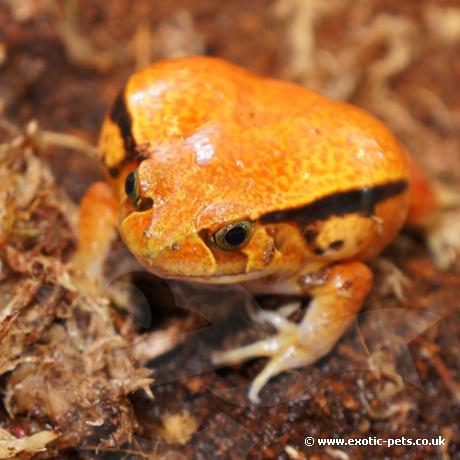

The False Tomato Frog is named due to their skin colouration which is orange to red. They only inhabit the forest floors of Madagascar living within the leaf litter.
| Origin | Madagascar |
|---|---|
| Environment | Forest Floor |
| Adult Size | 5 to 10cm |
| Suitability | Beginner |
| Lifespan | Unknown |
False Tomato Frogs are known to many as Tomato Frogs, this is the only species available in captivity. They are a lovely red to orange colouration with a dark line running from their eyes to the belly area. Males and females can often be distinguished by their colours, females tend to be more vibrant red with males being almost rusty brick coloured. Females grow to a larger size than the males reaching 9-10cm (3.5-4 inches), whereas, males generally stay around 5.5-6.5cm (2-2.5 inches) in size.
The coloration of the False Tomato Frog also gives us an indication to their health, a dull Tomato frog is not a happy frog and you may need to check their living conditions.
If a False Tomato Frog is attacked or feels threatened, it will inflate with air and blow up like a balloon. They will also excrete a distasteful slime from their skin to avoid being eaten.
The False Tomato Frog originates from Madagascar only. Here they dwell within the rainforests often hiding and burrowing into the forest floor amongst leaf litter. Being ambush predators the leaf litter gives them camouflage, when insects pass their way they lunge forward to catch their food.
Glass terrestrial terrariums are the most suitable housing for this species, as they spend most of their day on the forest floors burrowing into the soil and amongst leaf litter. Glass terrariums are also better for holding humidity levels and being well ventilated they prevent stagnant conditions. A baby Tomato Frog requires a minimum size of 30x30x30cm, adults would be better suited to a 45x45x30cm terrarium.
Canopy tops are available for the glass terrariums which help provide a low wattage UVB output. The use of a jungle dawn lighting will help with plant growth if providing live plants in the enclosure. Heating the enclosure with the use of mini deep dome or nano dome can provide the correct air temperature. When using basking or heat bulbs we always recommend a thermostat to help with the control of the temperatures and prevent overheating. False Tomato Frogs require a daytime temperatures around 24-27C (75-80F), night time temperatures can drop as low as 18C (65F).
Soil based substrates are the best and most natural to use, when housing False Tomato Frogs. The soil allows them to express natural behaviours such as burrowing, moss can be added to provide humid spots and also to decorate the floor. Leaf litter scattered along the enclosure floor also gives the frogs a more natural surrounding and provides a place for hiding. Resin caves and natural hides can also be placed in the enclosure, these provide a safe area to retreat during the day.
Live plants can be added to the enclosure giving a natural look, be sure to research which plants are safe for use or have a look through our live plant section.
False Tomato Frogs eat a variety of appropriate sized livefood including crickets, locusts, flies, earthworms and calci worms. The food should be dusted with a calcium powder supplement 3-4 times a week and vitamin and mineral powders once a week. Studies have shown that Tomato Frogs fed on a well supplemented diet show better and brighter skin colourations compared to those that don’t.
Remember to provide your frogs with a water bowl large enough for them to sit in. Always use dechlorinated water, never use water straight from the tap, this can be harmful and dangerous. Daily misting is recommended to help keep humidity levels up above 70%.